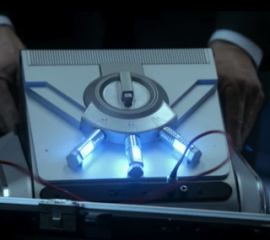
In season 5, episode 10 of Fringe, the Observers, hot on the trail of Walter and the gang, use an “LQ-7 unit” in Nina’s office to reconstruct the conversation she had a few minutes earlier. The Observers stick sensors to the glass doors, spray the doors with a special resonance-enhancing mist, and then capture the echoes of the soundwaves. A device then tries to convert them into audible words, which takes some doing, but eventually the Observers get the information they need. Nina never imagines that her glass doors will spill her secrets, which raises the question of what information objects in our homes can hang on to and whether bald time travelers or anyone else could possible gain access to it.

It’s unclear whether the Observers specifically use ultrasound technology in that scene, but the process of putting suction cups on the glass and then spraying it with mist before scanning it with a handheld device mirrors the process by which doctors check out what’s going on in the womb of a pregnant woman. There is an ultrasound machine called LOGIQ 7, which may be where the Fringe writers got the idea. The LOGIQ 7 has a unit that resembles the Doppler decoding one used on the show, and its “TruAgent Detection” (a particularly fitting name, no?) software can collect echoed sound wave data in a number of different ways, which can help doctors figure out whether blood is flowing normally through a blood vessel, or whether arteries are blocked, much like the transducer used during a pregnancy ultrasound.
MIT researchers have developed another technology that can record sounds from objects, which they call the “visual microphone.” This process requires different equipment than the LQ-7, namely a high-speed video camera that captures the vibrations. The researchers cause objects, such as a potato chip bag, to vibrate–not by having classified conversations, but by playing music. Then, using an algorithm they devised, they can work backward to figure out the sounds that caused the vibrations. In the video below, scientists played “Mary Had a Little Lamb” from a speaker located near a plant. The naked eye can’t discern the vibrations of the plant when the music plays, but they’re there, as recorded by their camera, which has a frames-per-second rate higher than the frequency of the audio signal. Generally, the more high-tech the camera, the more clear the sound, but even fairly basic cameras can record enough information for them to use the algorithm and figure out the number of people speaking and their genders.
You don’t need something this high-tech in order to spy on people, though. In a scenario straight out of Orwell’s 1984, Samsung has warned that customers should “be aware that if your spoken words include personal or other sensitive information, that information will be among the data captured and transmitted to a third party through your use of Voice Recognition.” That’s right—if users activate voice recognition, their “voice data” is sent to Nuance Communications, Inc. (which Samsung named after the furor surrounding this warning) before it’s sent “to a server, which searches for the requested content then returns the desired content to the TV.” In other words, the Observers don’t have to go to your house with their LQ-7 unit or a visual microphone-style algorithm. They can simply pull your pertinent conversations from your television, or more accurately, from the third party that gathers all that info for Big Brother.

And if that’s not dystopian enough for you, check out the new “Hello Barbie” by Mattel, which is supposed to “learn about its users over time” after kids talk to it. But here’s the catch—kids don’t just talk to Barbie. Instead, they press a button, which records what they’re saying and then sends it to someone at ToyTalk, the company that developed the technology. And then that person comes up with a response. Oh, and everything the doll records can be forwarded to kids’ parents, too. This Barbie is definitely going to fix Mattel’s plummeting sales. Many consumer groups have protested the new Barbie, but Mattel insists that the toy is legal and that “girls have always wanted to have a conversation with Barbie.” Yeah, I bet that’s what Winston thought too.
